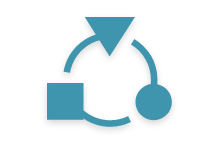Why does 4d concept focus on XML technologies?
Understanding XML
XML (Extensible Markup Language) allows you to describe and organize information in a way that is easily understood by humans and computers.
You can better share this information and its description with others via the Internet, a network or any other means.
You can use XML to create your own markup language with rules and tags that describe your data, your products.
These rules and tags are usually described in a document called a DTD (Document Type Definition) or an XML schema file.
XML is therefore the ideal format if you want to create a way to easily share information with your partners and suppliers or to dialogue with machines (printers, measuring devices, computer interfaces, etc.).
What’s more, DTD and XML schema define the standard for your electronic exchanges: in addition to having the same language, you define the same communication rules.
HTML, XML, what are the differences?
XML and HTML both use tags but there are some differences:
HTML
HTML describes how to format the information to be displayed; it is made for computer-human interaction.
XML
XML describes what the information is; it is for computer-to-computer interaction.
What does XML do?
The benefits of XML include:

Readability
XML uses a human language, not a computer language. It is easily readable and understandable.

Open source
XML is an open format.

Customizable
XML is customizable, it can be added to. This is called specialization.
WHERE CAN YOU FIND XML?
XML is widely used for web, e-business and portable applications.
XML is ideal for:
Web search and web task automation:
When XML defines the type of information in a document, search engines more readily index documents, and produce better results during web search requests.
For example, if you search for “Paris Hilton”, you will find instances of the term “Paris” outside the original context. You must use the appropriate context if you want the data in the <persons> tag to be returned.
General applications:
XML is a standard method of storing data that makes it easy for applications and devices of all kinds to use, store, send, and display data.
Ubiquitous computing:
Mobile phones, embedded computers, and other ubiquitous (wireless) computing set-ups can display portable and structured information-types thanks to XML. For example, WML (Wireless Markup Language) and VoiceXML describe the visual and voice interfaces of wireless devices.
Web publishing:
XML enables the creation of interactive pages, permits third parties to change these pages, and makes it easier to build e-commerce applications.
With a style sheet for formatting and an XSL/XSLT transformation processor, various rendering styles can be used to match various devices.
E-business applications:
XML facilitates the use of electronic data interchange (EDI) for information exchange and B-to-C transactions.
Metadata applications
XML facilitates the expression of metadata in a portable and reusable format.
Standards and extensions around XML
Other standards and extensions to XML work together to make your information more mobile and useful.
XML can describe information, but it cannot do everything.
XML does not contain the behaviors, digital formatting and programs that enable interactions.
The same goes for links and interactions between systems, the transport of XML data, etc.
In addition to XML, 4D Concept implements:
APIs
Application Programming Interfaces (APIs) make use of XML information through a standard set of portable interfaces and commands, for example:
DOM, which allows you to access, manipulate and create data as programming objects with methods and events. DOM is suitable for cases where you want to parse a few XML documents but maintain a lot of control over their content.
SAX is the ideal API for dealing with large or numerous documents. This API allows you to obtain information from XML documents but does not allow you to add or modify data in XML documents.
NAMESPACES
NAMESPACEs are pointers that help you distinguish between different XML elements or attribute names; this is useful when using an XSLT stylesheet or multiple DTDs to avoid duplication and confusion between identical terms.
XML Schema
The XML Schema Language defines the logical structure of an XML document and offers more possibilities than a definition document (DTD): enumeration of minimum and maximum allowed elements, constraints on values, additional data types, and definitions of inherited data types, easy import and export of data, etc.
X-LANGUAGES
XSL and XSLT work together to allow you to display XML data in a variety of ways, such as in a browser or on a smartphone or in a printed brochure.
XLink allows you to connect your XML document to other resources on the web (files of all types, results in databases, etc.).
XPath and XPointer are languages that allow you to search and find data in the hierarchical structure of the XML document.
Why choose 4D Concept software?

Meaningful innovation
4D CONCEPT is acknowledged as innovative by all of its customers.
We do more than just help you implement your solutions for content production and management, and broadcasting; we raise the technological worth of your tools so that you can make your mark in a fiercely digital world.

Sustainability
Because we are passionate about our customers’ businesses and documentation engineering, we are always heavily involved in your projects and are thus devoted to sustainability.

Your partner
Our goal is to be more than just a supplier; we want to be a valued partner in your growth. Discover our strengths!
For further information
Discover our range of products

DOCUMENT WORKSHOP
Your editorial solution for producing technical documentation to ASD S-series and AIA ATA standards

HYBRID CONTENT MANAGEMENT
Enterprise Content Management and Electronic Document Management System for all digital formats

